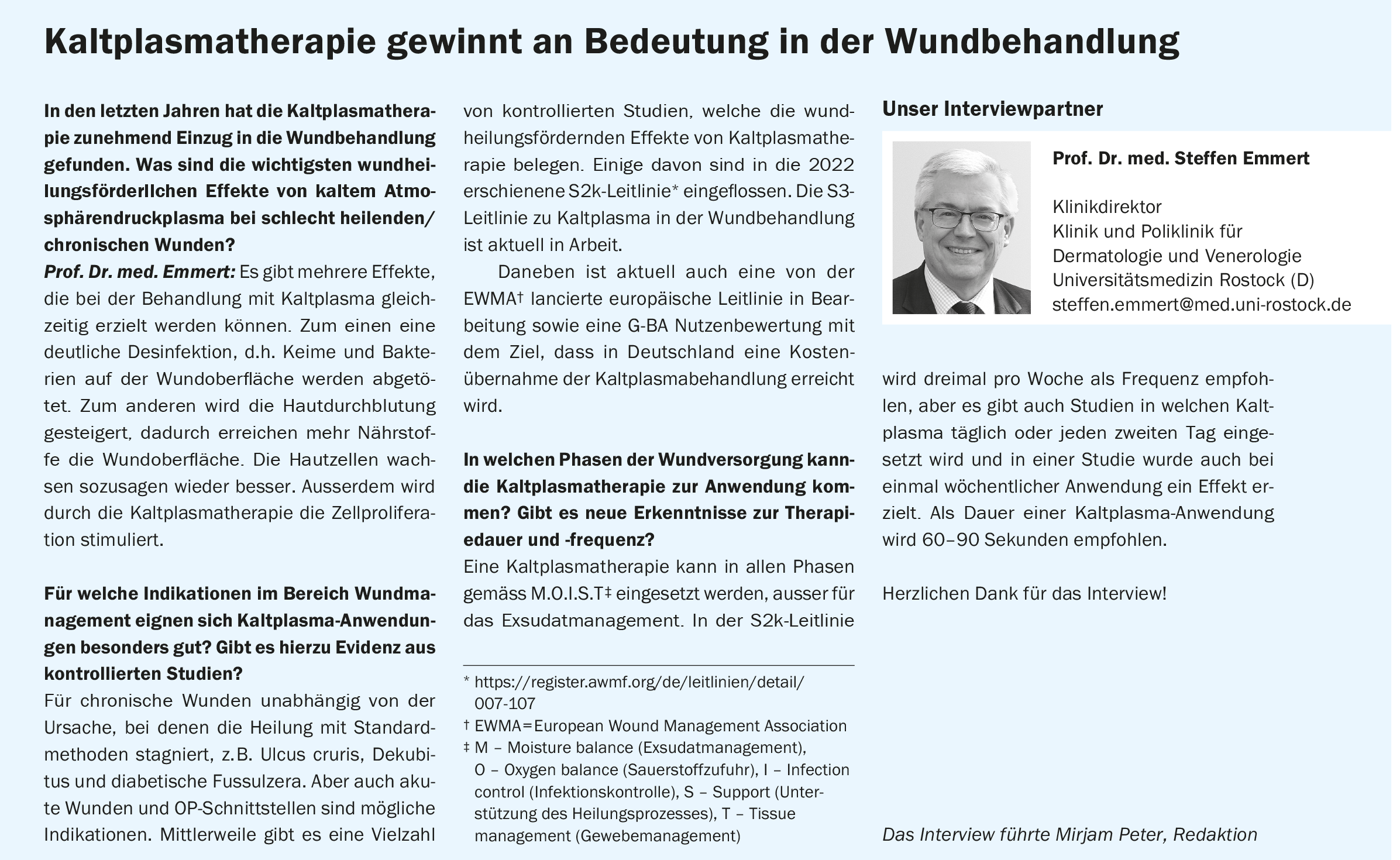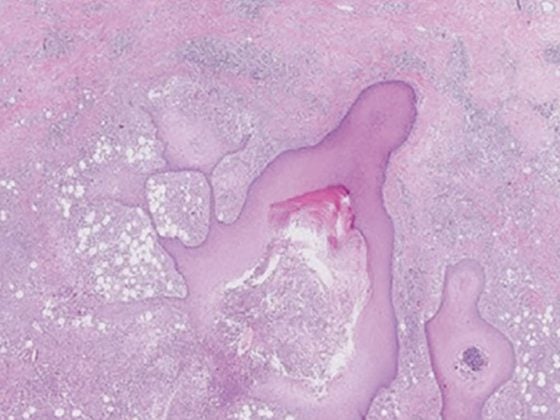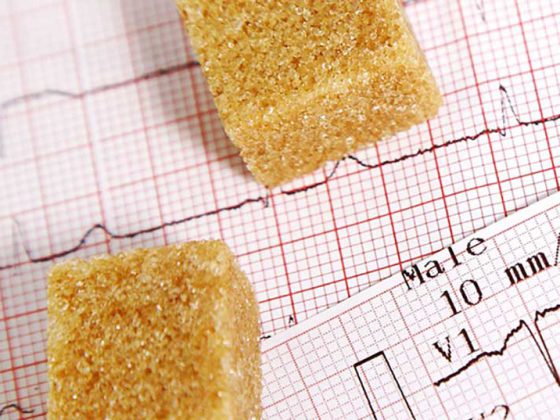Numerous clinical studies have shown that cold atmospheric pressure plasma has great potential for treating poorly healing and chronic wounds. It is an innovative method to accelerate wound healing. In addition to wound closure, better results were also achieved in patients with chronic wounds in terms of reducing the microbial load and improving quality of life when cold plasma was used in addition to standard wound treatment alone.
Professor Dr. Steffen Emmert, Director of the Clinic and Polyclinic for Dermatology and Venereology at Rostock University Medical Center, who co-chaired the main session “Cold plasma in wound treatment” with Penelope Kühn, Podiatry Practice, Nastätten, has been researching plasma medicine for over a decade [1]. In 2022, an S2k guideline on the therapeutic use of cold plasma was published [2]. This shows, among other things, that cold plasma application can support wound healing in cases where a weakened general condition, certain pre-existing conditions or other factors increase the risk of healing complications.
What are the active components of cold atmospheric pressure plasmas?
Cold physical plasma within the meaning of the guideline is ionized gas in the temperature range of body temperature that can be generated and applied directly during treatment using devices approved as medical devices. Dr. rer. nat. Lars Böckmann, Clinic and Polyclinic for Dermatology and Venereology at Rostock University Medical Center, gave an up-to-date overview of cold plasma treatment and the evidence for its wound-healing effects. According to the current state of research, reactive nitrogen and oxygen species, UV radiation and electric fields are the main active components of cold atmospheric pressure plasmas. This provides a “cocktail” of effective components which, in principle, together constitute the medically usable biological effectiveness of cold atmospheric pressure plasma [1,2]. Currently, two main plasma effects are used for medical applications: the effective inactivation of microorganisms, including multi-resistant pathogens, and the stimulation of cell proliferation and microcirculation, which results in the regeneration of damaged tissue [1,2].
| Nowadays, various methods are available for physical wound therapy, including photobiomodulation therapy, current/laser therapy, magnetic fields or atmospheric cold plasma [12]. The latter is most common in chronic wounds. In addition to some clinical studies and case reports, more recent randomized clinical studies are now also available that demonstrate the effectiveness of cold plasma therapy [6–8], although it should be noted that cold plasma should always be used in combination with stage-appropriate wound therapy [12]. |
Effective for infected and non-infected chronic wounds
Clinical studies and case reports document the effects of cold atmospheric plasma ( CAP) therapy on wound healing. The following is a selection of randomized clinical studies of different CAP devices in various wound entities:
In a randomized, prospective clinical study by Strohal et al. In 2022, a cold plasma jet kINPen® MED was evaluated in 78 patients with infected or non-infected chronic wounds in comparison to best practice standard treatment [3]. A significantly faster reduction of the wound area was achieved with CAP application (p<0.001) and the total amount of granulated tissue was higher (p<0.0001). Complete healing of chronic ulcers was documented after six weeks in 58.97% of patients in the CAP-Jet arm compared to 5.13% in the best-practice standard treatment.
In two placebo-controlled randomized studies by Isbary et al. CAP therapy showed a high antimicrobial potential in patients with various types of chronic wounds [4,5].
In a randomized controlled monocentric study published in JEADV in 2015 in patients with at least one chronic venous ulcer (n=14), CAP therapy with PlasmaDerm® in addition to standard care achieved a more pronounced reduction in wound size after three weeks (5.30 cm2 vs. 3.40 cm2) than in the group with standard wound treatment alone [8]. Both groups were treated three times a week for a total of eight weeks and then followed up for four weeks.
In a randomized controlled trial of cold plasma therapy for diabetic foot ulcers (n=20) by Samsavar et al. In 2021, cold plasma therapy was carried out twice a week for six consecutive weeks in addition to standard wound treatment [9]. In the sixth week of treatment, the wound grade was significantly better in the cold plasma arm (p=0.019) and there was also a significant reduction in the size of the ulcers (p=0.007). In addition, a significant reduction in wound exudate was documented in the cold plasma group in the third week after the six-week treatment phase (p=0.039).
Power study underpins evidence-based effectiveness
Dr. med. Nessr Abu Rached, assistant physician, Clinic for Dermatology, Venereology and Allergology, Ruhr University Bochum, presented the power study [1]. The randomized controlled multicenter power study investigated the efficacy of large-area, automated cold plasma therapy (CPT) for the treatment of chronic, non-healing wounds in comparison with standard therapy [10]. Patients aged ≥18 years with arterial or venous chronic ulcers in the lower leg area who were not acutely infected at baseline and did not require antibiotic treatment were included. The wound area ranged from 5 to 100 cm2. The CPT®patchwas used as a cold plasma device in combination with the CPTcube, creating a homogeneous plasma field over a large treatment area (10×10 cm). The following is an overview of the most important study results:
Accelerated wound healing rate: Data from 47 patients were analyzed in the GLS (Generalized Least Squares) regression model. Baseline characteristics such as age and gender were adjusted. CPT led to a significant acceleration of the wound healing rate compared to standard wound therapy. Improved wound closure could already be observed on day 2, and this trend continued until week 25. Compared to standard wound treatment, the wound closure factor in the CPT group increased by 214 percent.
Reduced need for antibiotics: The CPT group required only 4 percent antibiotics compared to 23 percent in the standard care group. The analysis of the reduction in microbial load relates to the period from the first visit to the last treatment. During this period, a total of 6 patients required antibiotic therapy, 5 of the 22 patients in the standard care group and 1 of the 26 patients in the cold plasma group. This shows that the incidence of antibiotic use was higher in the standard care group than in the CPT arm. In the Pearson Chi-Square test, this difference proved to be significant (p-value = 0.049).
Pain relief: Patients in the CPT group reported less wound pain and a reduction in passive pain to 0 (median) was recorded.
Improvement in quality of life: A strong and clinically significant improvement in quality of life was observed in patients in the CPT group (p=0.0001). Quality of life was measured using the validated SF-12 questionnaire, the short form of the SF-36 questionnaire [11]. The items of the SF-12 include dimensions such as physical functioning, general health, energy/fatigue and mental health. The questionnaire results are presented using two scores – one for the physical component (Physical Component Summary score, PCS) and one for the mental component (Mental Health Component Summary score, MSC) . The CPT group performed better in the MCS in particular.
In summary, the power study confirms that the combination of plasma treatment with standard wound treatment for chronic wounds is superior to standard wound treatment alone in terms of efficacy and improvement in quality of life. The acceleration of wound healing was already noticeable after the first treatment with CPT and improved continuously until day 25.
Congress: Wound Congress Nuremberg
Literature:
- “Cold plasma in wound treatment”, main session 3, Wound Congress Nuremberg, November 23-24, 2023.
- “S2k guideline Rational therapeutic use of cold physical plasma”, as of 23.02.2022, https://register.awmf.org/assets/guidelines/007-107l_Rationaler-therapeutischer-Einsatz-von-kaltem-physikalischem-Plasma_2022-02.pdf,(last accessed 23.01.2024)
- Strohal R, et al: Chronic wounds treated with cold atmospheric plasmajet versus best practice wound dressings: a multicenter, randomized, non-inferiority trial. Sci Rep 2022 Mar 7; 12(1): 3645
- Isbary G, et al: Successful and safe use of 2 min cold atmospheric argon plasma in chronic wounds: Results of a randomized controlled trial. Br J Dermatol 2012; 167: 404-410.
- Isbary G, et al: A first prospective randomized controlled trial to decrease bacterial load using cold atmospheric argon plasma on chronic wounds in patients. Br J Dermatol 2010; 163: 78-82.
- Stratmann B, et al: Effect of cold atmospheric plasma therapy vs standard therapy placebo on wound healing in patients with diabetic foot ulcers: A randomized clinical trial. JAMA Netw Open 2020; 3: e2010411.
- Moelleken M, et al: Pilot study on the influence of cold atmospheric plasma on bacterial contamination and healing tendency of chronic wounds. J Dtsch Dermatol Ges 2020; 18: 1094-1101.
- Brehmer F, et al: Alleviation of chronic venous leg ulcers with a hand-held dielectric barrier discharge plasma generator (PlasmaDerm VU-2010): results of a monocentric, two-armed, open, prospective, randomized and controlled trial (NCT01415622). JEADV 2015; 29: 148-155.
- Samsavar S, et al: The evaluation of efficacy of atmospheric pressure plasma in diabetic ulcers healing: A randomized clinical trial. Dermatol Ther 2021 Nov; 34(6): e15169.
- Abu Rached N, et al: Cold Plasma Therapy in Chronic Wounds-A Multicenter, Randomized Controlled Clinical Trial (Plasma on Chronic Wounds for Epidermal Regeneration Study): Preliminary Results. J Clin Med 2023 Aug 4; 12(15): 5121
- Gandek B, et al: Cross-validation of item selection and scoring for the SF-12 Health Survey in nine countries: Results from the IQOLA Project. International Quality of Life Assessment. J Clin Epidemiol 1998; 51: 1171-1178.
- Stürmer EK, Dissemond J: Evidenz in der lokalen Therapie chronischer Wunden: Was ist gesichert? Phlebologie 2022; 51(02): 79–87.
HAUSARZT PRAXIS 2024; 19(2): 43-44 (published on 20.2.24, ahead of print)












